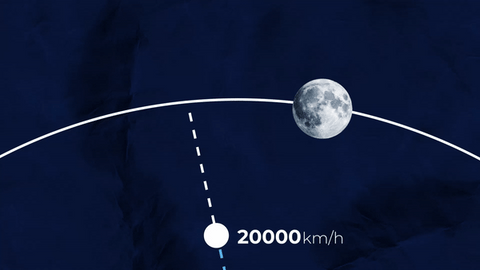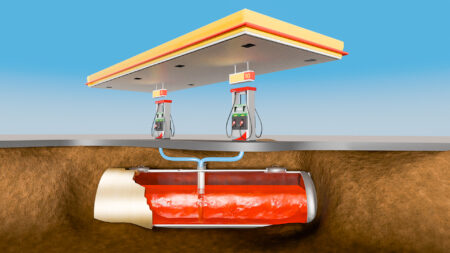In September 2002, astronomers discovered what they believed to be an asteroid in an unusual orbit around the Earth. This was a surprising discovery because, as far as they knew, the only natural object orbiting the Earth was the Moon.
With this in mind, and knowing that this strange object could not be an asteroid (despite its appearance), astronomers determined that it had to be something made by us.
As it turned out, this object was in fact a Saturn V third stage which had launched the Apollo 12 astronauts to the Moon decades ago. This rocket left Earth in 1969, before returning to Earth 30 years later … but what happened to this rocket in the meantime and how did it end up on such an unusual journey?

Before we talk about the journey, we have to talk about the launch. The Saturn V rocket had 3 stages. During its launch, the first stage burned for about 2 and a half minutes getting astronauts to an altitude of 61km. From there, the 2nd stage would burn for around 6 minutes taking them both higher and faster.
It was then up to the 3rd and final stage to do a short burn and get the spacecraft into orbit. Once it was in a stable orbit, the 3rd stage would be fired up again to perform the trans-lunar injection burn and send the rocket and crew on a trajectory to intersect the Moon.
Once the Apollo crew were safely on their way to the Moon, the 3rd stage would then separate and NASA would try to discard it.
On previous Apollo missions, NASA aimed to place it into an orbit around the Sun where it would remain for thousands of years and would be guaranteed not to get in the way of future missions … but things did not quite work out that way for Apollo 12.
Getting rid of Apollo 12’s 3rd stage
In order to get rid of Apollo 12’s 3rd stage, NASA had to set it on a path to meet the Moon, but the initial trajectory had it heading towards the wrong, or less ideal, side of the Moon. For this reason, the 3rd stage needed to do one final maneuver to change its trajectory.
In order to complete this maneuver, the 3rd stage used its auxiliary propulsion systems; two sets of thrusters at the bottom of the stage that provided yaw, pitch and roll control during flight.
Despite having to change its position by thousands of kilometers, this actually took very little energy since changing its trajectory so early in the journey would have a big effect once it reached the Moon. At the time of separation, the 3rd stage was traveling at around 20,000km/h.
In order to change its trajectory, it just had to slow down by about 140km/h. This would delay its approach to the Moon, making it arrive at the opposite side. NASA completed the maneuver, but unknown to them, it didn’t go to plan.

The entire Saturn V rocket was controlled by the instrument unit located above the 3rd stage. This had its own internal guidance unit onboard which was used to plot the rocket’s trajectory.
It also had two C-Band transponders, which would send signals back to ground stations on Earth, providing NASA with more accurate trajectory data.
Once the rocket was safely in orbit, NASA could compare this data with the rocket’s own data and see if it was following the desired flight path. If anything was off, they could send a command up to the rocket to correct it.
What NASA didn’t know was that the tracking system was off by a tiny amount, leading them to believe that the rocket was traveling faster than it really was. And so, in order to get it to the target velocity, NASA ended up slowing it down too much and overcorrecting by just 40mk/h.
This may not sound like much, but this was enough to drastically delay its arrival to the Moon, causing it to miss by thousands of kilometers.
This is why, instead of being thrown out into a solar orbit, the 3rd stage ended up in a highly elliptical orbit around the Earth. Over the next 15 months, the orbit was constantly stretched and pulled in different directions by the Earth and Moon’s gravity.
In fact, it got stretched all the way out to Lagrange Point 1 (a point between Earth and the Sun where the gravitational forces of both bodies cancel out).
It was only a matter of time though before the third stage would catch back up. This actually happened in 1986, but it wasn’t quite close enough to the L1 point – and so it never got pulled into Earth’s orbit. The 3rd stage carried on racing around the Sun for another 16 years before the inevitable finally happened.
In 2002, the 3rd stage reached its apoapsis just as the Earth came onto the scene. This time, the third stage crossed beyond Earth’s L1 point and (for the first time in 32 years), the Earth now had more pull on the object than the Sun.
Over the course of two months, Earth pulled the 3rd stage into another highly elliptical orbit around it, just like the one it was in before. It’s important to remember though that at this point in time, astronomers still had no idea what this object was.

In order to confirm the identity of the object, astronomers did spectrography observations to determine what the object was made of. Every material reflects light in slightly different ways and, more specifically, the amount of light that is reflected will differ at each wavelength.
To determine the material of this object, astronomers took light measurements of the third stage at many different wavelengths, which gave them a spectroscopy graph. With this, they could compare it to other spectroscopy graphs and see if it matched any other materials.
It turned out it was very similar to the spectroscopy graph of white titanium oxide paint, the exact kind that was used on the Saturn V. Astronomers were also able to then trace the object’s trajectory back to find that it left Earth’s orbit in 1971.
With this information, astronomers could confidently say that this really was the long lost 3rd stage from Apollo 12. Astronomers continued to track the orbit, and after just a year, it was once again thrown out into an orbit around the Sun.
Calculations made by astronomers show that it will eventually return to Earth again in the mid 40’s, but this object will spend many more years racing through space.













I don’t think the title of your article matches the content lol. Just kidding, mainly because I had some doubts after reading the article.